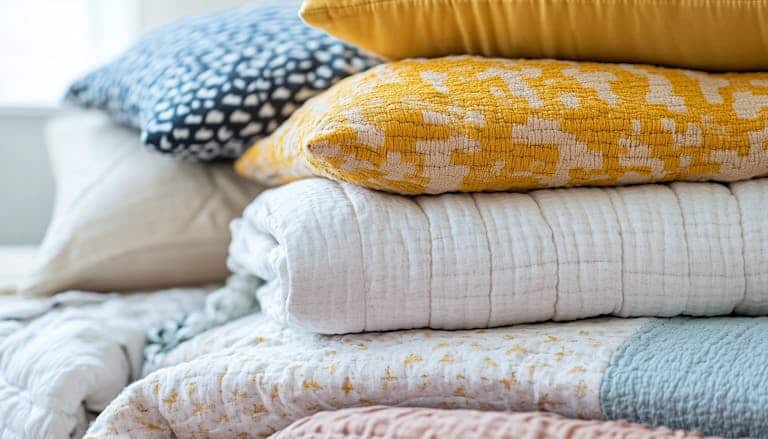Choosing the perfect bed sheets may seem like a simple task, but with so many options available on the market, it can quickly become overwhelming. From materials like cotton and linen to thread counts ranging from 200 to 1000, there are countless factors to consider when selecting the ideal bedding for your bedroom. In this comprehensive guide, we will explore everything you need to know about choosing the perfect bed sheets, including an in-depth look at different materials, thread counts, weaving techniques, and more. Whether you prioritize softness, durability, or breathability in your bedding choices, this ultimate guide will provide you with all the information you need to make an informed decision that will enhance both your comfort and style in the bedroom.
Understanding Different Types of Bed Sheet Materials
When it comes to selecting the perfect bed sheets, the material plays a significant role in determining comfort and durability. Here are some common types of bed sheet materials:
- Cotton: Known for its breathability and softness, cotton is a popular choice for bed sheets. It can be either regular cotton or high-quality Egyptian or Pima cotton.
- Linen: Linen sheets are durable, moisture-wicking, and offer a luxurious feel. They are perfect for hot sleepers due to their excellent breathability.
- Microfiber: Microfiber sheets are affordable, wrinkle-resistant, and easy to care for. However, they may not be as breathable as natural fibers like cotton or linen.
Choosing the right material for your bed sheets can make a big difference in your sleep quality and overall comfort.
Decoding Thread Count: What Does it Really Mean?
- Thread count is a term often thrown around when discussing bed sheets, but what does it truly signify?
- It refers to the number of horizontal and vertical threads per square inch in a fabric.
- A higher thread count doesn’t always mean better quality; look for a range between 200 to 800 for optimal comfort.
When shopping for bed sheets:
- Focus on the material first – cotton, linen, or silk
- Then consider thread count – aim for that sweet spot between 200 to 800
- Remember that thread count isn’t everything – factors like weave and material also impact the feel of your sheets.
Weaving Techniques: Sateen vs Percale
Sateen and percale are two common weaving techniques used to create bed sheets.
- Sateen sheets have a luxurious feel with a silky smooth finish, thanks to their satin weave that exposes more thread surface on the face of the fabric.
- On the other hand, percale sheets have a crisp and cool feel due to their traditional one-over-one-under plain weave that gives them a matte appearance.
When selecting between sateen and percale bed sheets:
- Consider your personal preference for texture and comfort.
- Keep in mind that sateen may be prone to pilling over time, while percale is known for its durability and breathability.
Factors to Consider When Choosing Bed Sheets
- Material: Consider the material of the bed sheets carefully. Cotton is a popular choice for its breathability and durability, while silk offers a luxurious feel. Polyester blends are more affordable but may be less breathable.
- Thread Count: Higher thread count doesn’t always mean better quality. A thread count of 200-400 is sufficient for most people, providing a balance between softness and durability.
- Weave: Look at the weave of the fabric – percale is crisp and cool, while sateen has a smooth and silky feel. Choose based on your personal preferences for texture when selecting bed sheets that best suit your needs.
Breathability and Moisture-wicking Properties
When choosing bed sheets, it is important to consider their breathability and moisture-wicking properties. Sheets that allow air to flow through them help regulate body temperature while sleeping, keeping you cool in the summer and warm in the winter. Look for materials like cotton or linen which are known for their breathable nature.
Additionally, moisture-wicking sheets can help keep you dry throughout the night by pulling sweat away from your body. This is especially beneficial for hot sleepers or those prone to night sweats. Opt for fabrics such as bamboo or Tencel that have moisture-wicking abilities to ensure a comfortable sleep environment.
In summary, prioritize bed sheets with good breathability and moisture-wicking properties like cotton, linen, bamboo, or Tencel to enhance your overall comfort while asleep. These qualities will not only help regulate your body temperature but also prevent excess sweating during the night, leading to a more restful sleep experience.
Durability and Longevity of Bed Sheet Materials
When considering the durability and longevity of bed sheet materials, it’s essential to choose fabrics that can withstand regular wear and washing without losing their quality. Cotton sheets, especially those made from long-staple cotton like Egyptian or Pima, are known for their durability and softness. These sheets tend to get softer with each wash while maintaining their strength.
Another durable option is linen, which is a natural fiber known for its breathability and ability to last for years when properly cared for. Linen may feel slightly rougher than cotton at first but becomes softer over time. Additionally, high-quality microfiber sheets can also offer excellent durability while being more affordable than luxury fabrics like silk or satin.
Consider investing in bed sheet materials that strike a balance between comfort and longevity to ensure you enjoy restful nights for years to come.
Tips on Maintaining Bed Sheet Longevity
- Wash your sheets regularly according to manufacturer instructions.
- Avoid using harsh chemicals or bleach on your bed linens.
- Rotate between different sets of sheets to reduce wear and tear.
- Use gentle detergents specifically formulated for delicate fabrics.
- Consider line drying your sheets instead of using a dryer to extend their lifespan.
By following these tips and choosing durable bed sheet materials, you can enhance the longevity of your bedding investment while ensuring a comfortable sleep environment night after night.
Care Instructions for Different Types of Bed Sheets
- Cotton Sheets: Machine wash in cold water on a gentle cycle with mild detergent. Tumble dry on low heat and remove promptly to minimize wrinkles. Iron if needed but avoid high heat.
- Silk Sheets: Hand wash in lukewarm water with gentle detergent or use the delicate cycle on your washing machine. Avoid twisting or wringing out silk sheets, instead gently press out excess water and air dry away from direct sunlight.
- Linen Sheets: Machine wash on a cool or warm cycle with mild detergent. Tumble dry on low heat until slightly damp, then hang to finish drying fully to maintain their natural texture. Avoid over-drying linen to prevent shrinkage and preserve its softness.
Finding the Perfect Balance of Comfort and Style
When selecting bed sheets, it’s essential to find a balance between comfort and style. You want sheets that feel luxurious against your skin while also enhancing the aesthetic of your bedroom.
- Look for materials like Egyptian cotton or bamboo for a soft, cozy feel.
- Consider the thread count; higher counts typically mean softer sheets.
- Choose colors and patterns that complement your existing decor for a cohesive look.
By prioritizing both comfort and style when choosing bed sheets, you can create a relaxing oasis in your bedroom that reflects your personal taste.
Understanding Different Materials: Cotton, Linen, Silk, and More
- Cotton: Known for its softness and breathability, cotton bed sheets are a popular choice. They are easy to care for and come in a variety of weaves such as percale or sateen.
- Linen: With a more textured feel compared to cotton, linen sheets offer excellent moisture-wicking properties and become softer with each wash.
- Silk: Luxurious and smooth to the touch, silk sheets are ideal for those seeking a luxurious feel. They regulate temperature well but require delicate care.
When selecting bed sheets, consider the material that will best suit your preferences—whether you prioritize comfort, durability, or luxury. Each fabric has its unique characteristics that cater to different needs.
Decoding Thread Count: What Does it Really Mean?
- Thread count is the number of horizontal and vertical threads woven into one square inch of fabric.
- Contrary to popular belief, a higher thread count does not always equate to better quality or comfort.
- Manufacturers may inflate thread counts by using multi-ply yarns, making sheets feel heavier but not necessarily softer.
When choosing bed sheets:
- Instead of focusing solely on thread count, consider other factors like material and weave.
- Opt for long-staple cotton such as Egyptian or Pima for softer, more durable sheets.
- Look for percale or sateen weaves depending on your preference for crispness or smoothness.
Remember: A balance of all these elements will ultimately determine the quality and feel of your bed sheets, not just the thread count alone.
Weaving Techniques: Percale vs Sateen
Percale: Known for its crisp and cool feel, percale sheets are made with a traditional one-over-one-under weaving technique. This results in a matte finish and excellent breathability, making them perfect for hot sleepers or warmer climates.
Sateen: In contrast, sateen sheets use a three-over-one-under weave that creates a silky-smooth surface with a subtle sheen. These sheets are softer to the touch and have a luxurious drape, ideal for those seeking a more lavish sleeping experience.
When choosing between percale and sateen sheets, consider your preferences for texture, temperature regulation, and overall comfort. Both weaving techniques offer unique benefits that can enhance your sleep quality based on personal needs and preferences.
Breathability and Moisture-Wicking Properties
When choosing the perfect bed sheets, it’s essential to consider their breathability and moisture-wicking properties. Sheets that are breathable allow air to flow through them, preventing you from overheating during the night. Look for materials like cotton or bamboo, which are known for their breathability.
Moisture-wicking sheets can help keep you dry and comfortable throughout the night by pulling sweat away from your body. Fabrics like Tencel or linen are great options if you tend to get hot while sleeping. These materials have natural properties that make them excellent at absorbing moisture and keeping you cool.
In conclusion, prioritize selecting bed sheets made from breathable fabrics such as cotton or bamboo and those with moisture-wicking properties like Tencel or linen for a comfortable night’s sleep. By paying attention to these factors, you can ensure that your bedding enhances your overall sleeping experience.
Finding the Perfect Balance: Softness, Smoothness, and Weight
When selecting bed sheets, it’s crucial to find the perfect balance between softness, smoothness, and weight. Soft sheets provide comfort against your skin, while smooth sheets offer a luxurious feel. The weight of the sheets can also impact your sleeping experience.
- Softness: Look for materials like cotton or bamboo for a soft touch that feels gentle on your skin.
- Smoothness: Opt for high thread count sheets for a smoother finish that glides smoothly across your body.
- Weight: Consider the season and personal preference when choosing the weight of your bed sheets – lighter options are ideal for warmer months while heavier ones provide coziness in colder weather.
In conclusion, finding bed sheets with the right combination of softness, smoothness, and weight is essential for creating a comfortable sleep environment. By keeping these factors in mind during your selection process, you can ensure a restful night’s sleep every time you crawl into bed.
Durability and Longevity: How to Ensure Your Sheets Last
- Invest in Quality: Look for sheets made from durable materials like Egyptian cotton or linen, as they are more likely to stand the test of time.
- Proper Care: Follow care instructions carefully, including washing in cold water, using mild detergent, and avoiding harsh chemicals that can break down fibers.
- Rotate your Sheets: Have multiple sets of sheets to rotate between washes, giving each set a chance to rest and regain its shape.
By following these simple steps, you can ensure that your bed sheets stay soft and comfortable for years to come. With proper maintenance and quality materials, you can enjoy a good night’s sleep without having to constantly replace worn-out sheets.
Care and Maintenance: Washing and Drying Tips
- Always check the care label on your bed sheets before washing.
- Use a gentle cycle with cold water to preserve the quality of the fabric.
- Avoid using harsh detergents or bleach as they can damage the fibers over time.
It is recommended to dry your bed sheets on a low heat setting, or hang them outside to air dry. This will prevent shrinkage and help maintain their softness. Avoid wringing out your sheets excessively as this can cause wrinkles and weaken the fabric. By following these simple washing and drying tips, you can extend the lifespan of your bed sheets and keep them looking new for longer.





